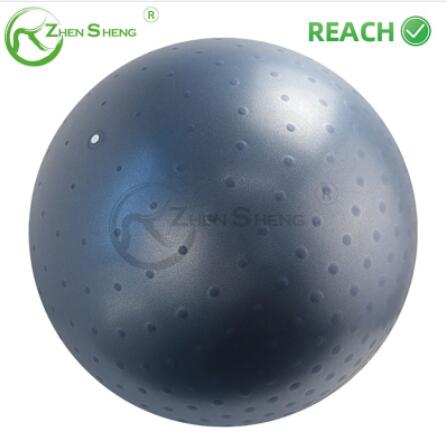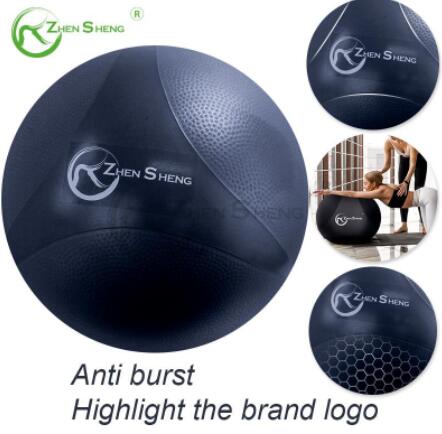What is versatile, soft, flexible and full of air? Therapy balls (also known as exercise balls, Swiss balls, balance balls, birth balls, body balls, balls, fitness balls, gym balls, gymnastic balls, physio balls, Pilates balls, Pez balls, exercise balls, stability balls, Swedish balls, or yoga balls, to name just a few). By being fully or partially inflated using a high-capacity hand pump or an electric pump, therapy balls can be used in a variety of ways and evolve over time.

The Italian plastics manufacturer Aquilino Cosani developed the first Swiss ball and the process for moulding large plastic balls in 1963. Mary Quinton, a British physiotherapist working in Switzerland, used the balls for the treatment of newborns and babies. Later, Dr Susanne Klein-Vogelbach, director of the Basel School of Physiotherapy in Switzerland, used the ball as physiotherapy for neurodevelopmental treatment. The concept was later taken to North America, where the therapy ball is commonly used in almost every physiotherapy clinic.
Therapy balls offer several benefits.
1. Muscle recruitment
A major benefit of using the exercise ball is that the body responds to the instability of the ball by recruiting the muscles of the core, legs and arms to deal with the instability. As a result, more muscles can be recruited than when working out on a flat surface. For example, when you lie prone, press your abdomen into the ball and lift your legs, you are working your upper arms, legs and core muscles at the same time.
2. Neural development
The therapy ball is an extraordinary tool to help children with developmental delays. With the hands-on support of a trained therapist, the ball is used to place the child in developmental positions (abdominal, back, limb, high kneeling or even standing) to encourage the body and brain to work in tandem.
3. Portability
The therapy ball is portable! Families can use the ball when travelling and therapists can bring it to different clients. Carry a small hand pump with you to inflate or deflate the ball to the desired level.
bl5680_double_action_hand_pump
4. Adjustable surface
You can fully inflate or partially deflate the ball to create a completely different sensory experience. A partially deflated ball feels more like a beanbag chair, or like you are riding a wave in the ocean. A fully inflated ball is more stable and is a great place to sit, move and bounce. You can also get tactile therapy balls with bumps to create a completely different sensory experience.
BL1879-Tactile_Sensory_Ball_boy
5. Good posture
It's a good idea to use your ball as a seat. The key is to bend your hips, knees and ankles to a 90 degree angle. This provides a movable seat to exercise your muscles while bouncing, playing games, watching TV or working at your desk. To determine the right size of ball for sitting and core balance activities, try this recipe: measure the length of your arm from your shoulder to your fingertips and choose the corresponding ball diameter. If you intend to use it as a balance ball with children, you can order any size you like.
6. Attention
Studies have shown that sitting on a therapy ball that works the core muscles can help improve concentration and focus. Combined with the gentle movement of the ball, this alert position helps to engage the brain and body.
For example, a study cited in the American Journal of Occupational Therapy (2003) reported that sitting on a therapy ball improved the behaviour and clear handwriting of students with ADHD. A study in the American Journal of Occupational Therapy (2011) cited the effect of a stability ball on the attention and hyperactivity levels of 76 children. It also assessed the impact on seating and on-task behaviour in eight children with ADHD and attention difficulties above the 92nd percentile. All children showed improvements in attention and reduced levels of hyperactivity through the use of stability balls. The greatest impact was seen in eight children who had significant difficulties prior to intervention implementation.
7 Eternity
Anyone can use the therapy ball from birth to old age (under supervision). From neurodevelopment to core exercises to yoga to restorative therapy, the ball has created the perfect surface for exercise over the years.

8. Durability
If properly maintained and stored in a room with a consistent temperature, the therapy ball will last for many years. A few quick air pumps will bring the ball back to the level of inflation you want.
Large or small? Smooth or bumpy? Round or peanut-shaped? With so many options, you don't have to go it alone! Contact our experienced team and we'll help you make the best choice for your home, classroom or clinic. Any time you want to play with a ball, Simply send an email to shzhensheng8758@gmail.com.
Previous: What is a Lever Belt and How Do I Wear It?
Next: Red Cross Tents
Copyright:@2020-2021
Comments Please sign in or sign up to post.
0
0 of 500 characters used